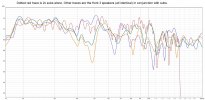Or as cleanly (distortion-wise). And speaker placement for the best imaging and such is rarely the best place for smoothest low-frequency response since room modes tend to occur around the listening area and not where the main speakers are placed.So, I get what you're saying here and I agree with a lot of it, but most speakers that we use as mains do go just about as low as subwoofers. They just don't do it as efficiently.
I never said that; I have repeatedly said you must optimize phase at the crossover frequency to provide a cohesive wavefront.You can high pass your mains, but that doesn't get us away from phase problems, especially at the crossover region.
You always have to optimize for the listening area. Multiple subs provide the flexibility to optimize a broader area. If you have one sub and correct the response in one spot, then other spots could be worse. If you EQ a peak for the listening spot, then other areas in the room will have less bass. As you add subs, or any speakers, overlapping sound fields become more complex, but provide greater ability to smooth the response across a wider area (you have more parameters to play with). In a room, church, or stadium you still have to time-align the speakers to provide a cohesive sound to the listeners.Also, I'm not saying that correcting for frequency response causes phase problems. I'm. saying that having multiple subwoofers can flatten frequency response but increase phase problems. You can correct for the nulls, but what happens to the spaces that were working properly. My concern is that you can add more problems than you fix, but again, I've never tried 3 subwoofers in a room. I'm merely trying to understand why this is a better approach.
You keep saying multiple subs can increase phase problems, and of course they can, but the idea is to use the tools we have to correct the phase (delay) to provide the best response. It is a better approach because it adds additional sources and thus parameters to use in correcting the response. If you have a single sub it is almost impossible to correct all the modes in a room. Different dimensions lead to different modal frequencies; speaker, listener placement cause differing peaks and valleys, the furnishings in the room can affect the response, etc.
Toole, Geddes, Welti et. al. explain this much better than I.
If you need to prove it to yourself there's not much point in talking (writing) more about it! I'm from Missouri and have a healthy streak of "show me!" but if you mistrust everything it is a lot of work to figure it out on your own. I have to defer to experts when it is outside my field.The reality is that I would have to hear it and see if I like it. In my experience with multiple subwoofers (mostly in arenas and other systems where we use sub arcs to decrease modes and create a more even low end response, we often sacrifice punch and clarity.) I'm wondering if that's what happens in small rooms also.
Punch and clarity is usually a function of frequencies above the subwoofers' range, at least in HT applications. For setting up an arena or other large venue, which is decades in the past for me, alignment was often difficult and constrained by not only the tools I had (no DSP then) but cost and placement constraints of the venue. If aligning deep bass caused loss in "punch and clarity" my first reaction would be that the sound system was not properly integrated and/or the subs had too much overlap with the other speakers. Of course, in rooms large or small it is virtually impossible to get the best sound in every seat, though enough drivers and processing power can come close.
Because they are generally at different places in the room so they exhibit different in-room frequency response. For example, if you place the subs to help cancel (mitigate) room modes, they will be in a different place and different physical environment than the other speakers and thus require different EQ.I question applying different EQ to mains and subwoofers when they're operating in the same frequency range in the same room. Wouldn't they have the same problems in the room?
The goal is to utilize crossovers and processing to optimize integration no matter how many subs are in play and minimize interaction with the mains. For example, my rather modest room has a primary mode (null) around 30 Hz, so anything I do to fix that has little impact on the main speakers using a 4th-order crossover at 80 Hz. My additional subs are not really "summing nodes", they are placed to drive the nodes (minima) and thus physically not in position to increase the antinodes (peaks).My basis here is that flat frequency is a great goal, but not if it sacrifices the listening experience in other ways (which I generally describe as phase problems). I see the same problem in some crossover designs where drivers sum flat but not in phase. When you add a subwoofer that flattens the response by canceling peaks but summing the nodes, does it not also effect other areas of the frequency spectrum and listening experience?
I do not believe anything I say will be meaningful to you so will drop this. For me, in my room, multiple subs were the only practical solution to smoothing the response, and I have not heard any negative effects as I went from one sub, to two, to four -- just better bass. No impact I could discern on higher frequencies, and the additional subs provided better bass across a wider listener area.

